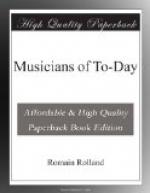The chief characteristic of these symphonies is, generally speaking, the use of choral singing with the orchestra. “When I conceive a great musical painting (ein grosses musikalisches Gemaelde),” says Mahler, “there always comes a moment when I feel forced to employ speech (das Wort) as an aid to the realisation of my musical conception.”
Mahler has got some striking effects from this combination of voices and instruments, and he did well to seek inspiration in this direction from Beethoven and Liszt. It is incredible that the nineteenth century should have put this combination to so little use; for I think the gain may be poetical as well as musical.
In the Second Symphony in C minor, the first three parts are purely instrumental; but in the fourth part the voice of a contralto is heard singing these sad and simple words:
“Der Mensch liegt
in groesster Noth!
Der Mensch liegt in groesster
Pein!
Je lieber moecht ich im Himmel
sein!"[194]
The soul strives to reach God with the passionate cry:
“Ich bin von Gott und will wieder zu Gott."[195]
Then there is a symphonic episode (Der Rufer in der Wueste), and we hear “the voice of one crying in the wilderness” in fierce and anguished tones. There is an apocalyptic finale where the choir sing Klopstock’s beautiful ode on the promise of the Resurrection:
“Aufersteh’n,
ja, aufersteh’n wirst du, mein Staub, nach
kurzer Ruh!"[196]
The law is proclaimed with:
“Was entstanden ist,
dass mus vergehen,
Was vergangen, auferstehen!"[197]
[Footnote 194: Man lies in greatest misery; Man lies in greatest pain; I would I were in Heaven!]
[Footnote 195: I come from God, and shall to God return.]
[Footnote 196: Thou wilt rise again, thou wilt rise again, O my dust, after a little rest.]
[Footnote 197: What is born must pass away; What has passed away must rise again.]
And all the orchestra, the choirs, and the organ, join in the hymn of Eternal Life.
In the Third Symphony, known as Ein Sommermorgentraum ("A Summer Morning’s Dream"), the first and the last parts are for the orchestra alone; the fourth part contains some of the best of Mahler’s music, and is an admirable setting of Nietzsche’s words:




